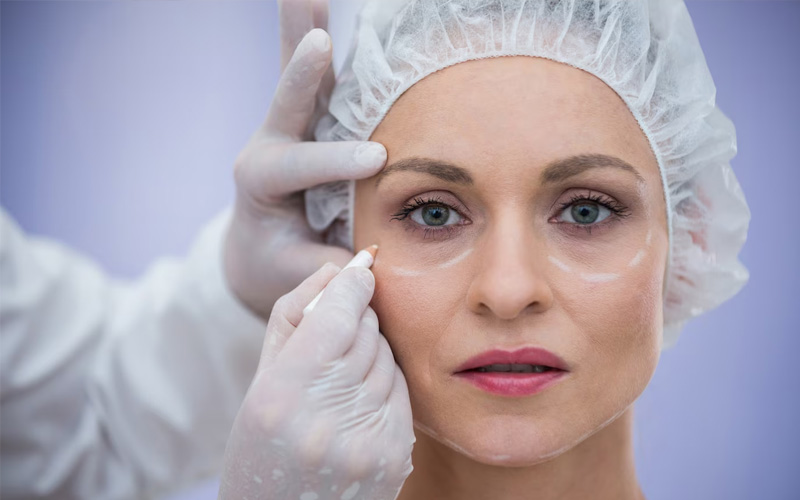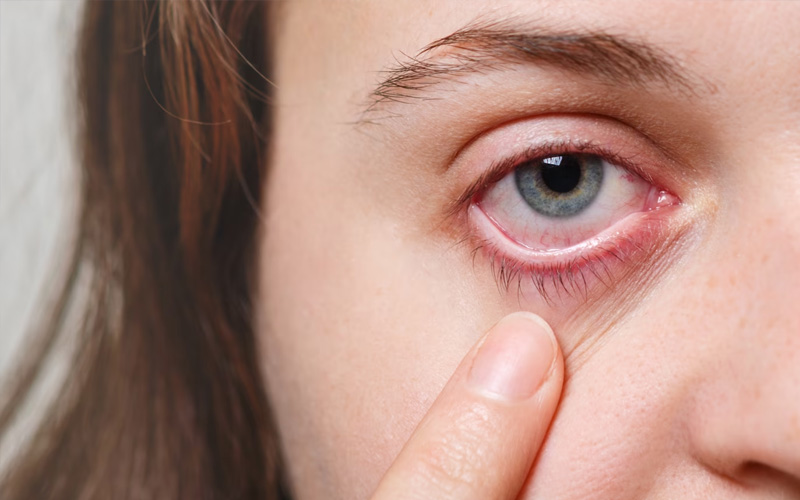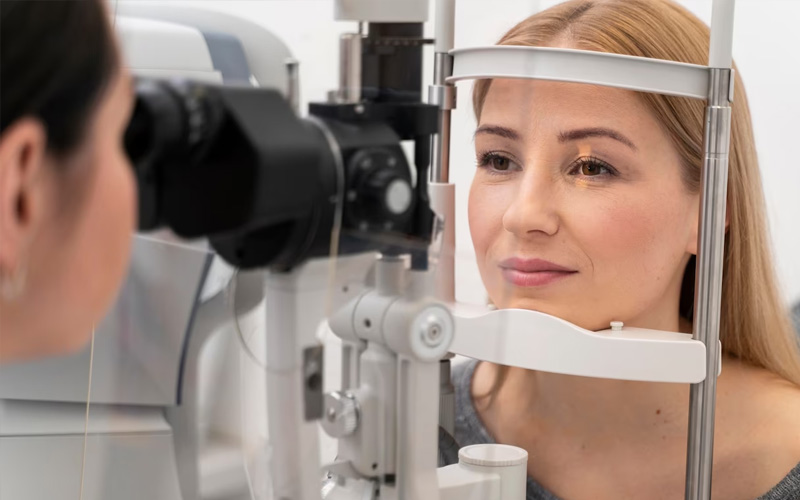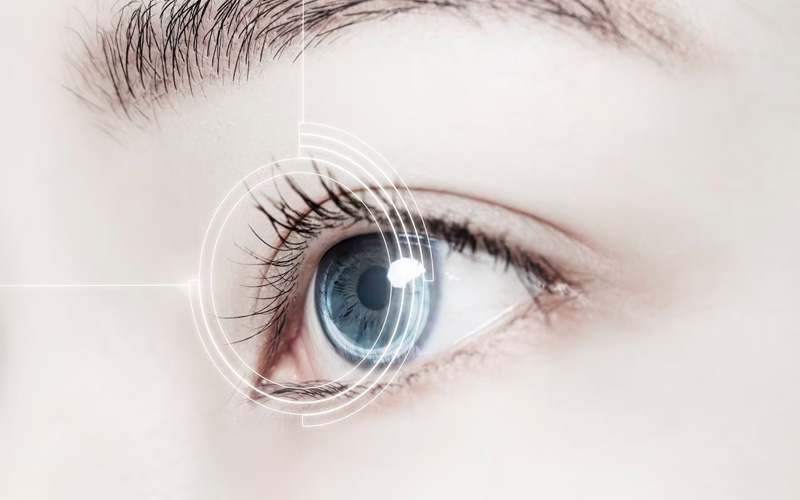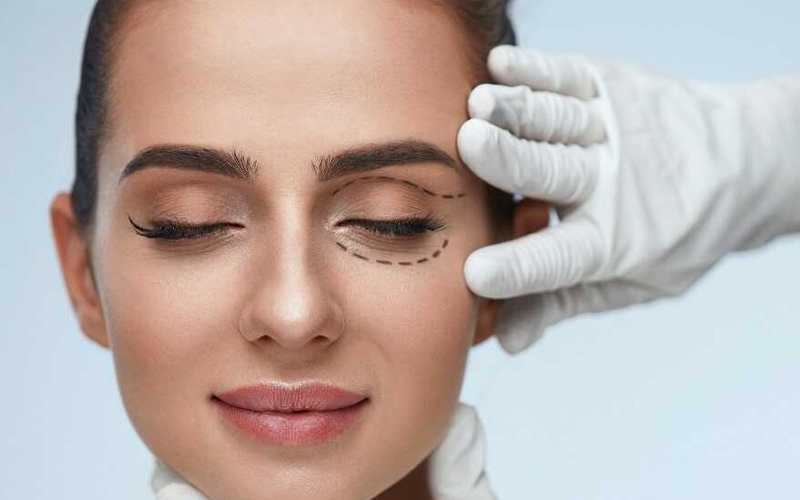Watery Eyes (Epiphora)
Watery eyes, known medically as epiphora, is a common condition. To fully understand the complaint of watery eyes, it’s important to first understand the tear mechanism.
Tear Mechanism
Our eyes are continuously covered by a tear film that is regularly secreted. Tears are produced by tear glands located within the eyelids and in the bony cavity known as the orbit. This tear film is crucial for the oxygenation, nourishment, protection against infections, and removal of waste from the eyes. After the tears are secreted and used, they are directed toward the tear drainage system with every blink, facilitating their removal.
One of the most important aspects of this drainage system is the act of blinking. When we blink, not only are the tears spread across the surface of the eyes, but the eyelids close from the outer edge inward, like a zipper, in a very short time. This action pumps excess tears into the drainage openings located on the inner surface of the eyelids. The excess tears then travel through these channels to a sac near the side of the nose, where they are collected. From there, they drain backward into the nasal cavity under negative pressure.
In certain situations where tear production increases or when there is an issue with drainage, the excess tears accumulate on the eye surface, causing watery eyes. This excess tear film can lead to symptoms such as eye irritation, burning, excessive watering, and blurry vision. In cases of severe watering, tears may overflow from the edges of the eyelids, prompting the need for constant wiping, which can lead to skin irritation and even damage to the eyelids and surrounding skin.
As mentioned earlier, watery eyes (epiphora) are primarily caused by two factors. The first is an increase in tear production. For example, crying is a natural and sometimes beautiful reason for increased tear production. However, crying is actually a reflex, triggered by reflex tear glands. Similarly, when a foreign object enters the eye, tear production increases reflexively. In cases of dry eyes, reflex tear glands are activated, leading to increased tear production and watery eyes. Additionally, infections can trigger increased tear production as part of the body’s immune response. Allergic reactions and certain systemic diseases can also cause excess tear production. In such cases, treating watery eyes requires an accurate diagnosis and addressing the underlying cause.
The second common cause of watery eyes, as mentioned, is a blockage in the tear drainage system. According to medical literature, this is the most frequent cause of epiphora. When used tears cannot be properly drained, the problem can become chronic, potentially leading to various pathologies around the eye tissues and even affecting the eye itself. In such cases, it is crucial to be evaluated by a doctor experienced in tear drainage systems and skilled in oculoplastic surgery.
- Blockage in the tear drainage system (the most common cause)
- Chronic dry eyes or conditions causing chronic irritation of the eye surface (the second most common cause)
- Dysfunction in the pump mechanism responsible for directing tears into the drainage system during blinking
- Infections
- Allergic reactions
- Foreign objects in the eye
- Immunological disorders
Blockage in the tear drainage system is identified as the most common cause of watery eyes (epiphora), according to research. The obstruction can begin at the puncta (small openings located on the inner sides of the upper and lower eyelids that serve as the entry point to the drainage system). The blockage can occur in the canaliculi (small channels that transport tears), in the nasolacrimal sac, or in the area where the sac drains into the nasal cavity. In these cases, it is crucial to accurately identify the cause and location of the blockage. The treatment approach will vary depending on the cause and severity of the obstruction.
One of the most frequently affected groups are newborns. About 1 in every 20 newborns has a congenital (present at birth) tear duct blockage.
In newborns, congenital tear duct blockage occurs not due to a complete obstruction but because the tear ducts haven’t fully opened. The primary cause is typically a few microvalves at the lowest part of the tear sac that block the exit of tears into the nasal cavity. Since the tear drainage mechanism doesn’t work efficiently, the baby’s eyes continuously water (epiphora), with tears overflowing down the sides of the eyes and cheeks. This is often noticed by parents early on.
Due to the blockage, infections are inevitable, and these babies often suffer from recurrent eye, conjunctival, and canalicular infections. Symptoms can include redness, discharge, swollen and painful eyelids, and sometimes even fever, causing significant discomfort for the newborn. Because of these noticeable symptoms, parents typically seek medical attention early. Sometimes, the condition is diagnosed during routine check-ups by pediatricians.
In cases of congenital tear duct blockage in newborns, it is essential to consult an ophthalmologist, ideally an oculoplastic surgeon, as early as possible. Usually, these babies are monitored until they reach 10-12 months of age, during which time massage and medical treatment are recommended, especially if infections arise. Massage is particularly important, and the ophthalmologist or oculoplastic surgeon should thoroughly explain the correct massage technique to the family. Since the blockage often occurs at the microvalve that hasn’t fully opened, proper massage can help open the ducts in the majority of cases (around 80%) by the time the baby is 10-12 months old.
If infections occur, the baby must be examined and treated by an eye doctor. However, if the blockage remains and epiphora persists despite massage by the time the baby is around one year old, surgical intervention may be necessary. At this age, the microvalves start to harden, so surgery should not be delayed. The procedure involves using special probes designed for tear ducts to open the blocked passages. In some cases, balloon dilation or intubation of the tear ducts may also be performed to ensure the ducts remain open.
Tear duct blockages can develop not only congenitally but also as a result of aging.
In these cases, especially in older adults, the location and severity of the blockage are crucial. One of the more common but often overlooked issues is the blockage of the puncta, the small openings at the beginning of the tear ducts. Patients with this condition often visit multiple doctors and take numerous medications without finding relief. In punctal blockage, using medications without addressing the tear drainage system can not only fail to improve the condition but also worsen it, causing patients to enter a cycle of ineffective treatments.
For punctal blockages, treatment options include opening and dilating the blockage in an office setting or performing a procedure under local anesthesia in a surgical environment. To prevent re-blockage, small plugs or tubes may be inserted. In more advanced cases, punctoplasty surgery, which modifies the punctal area to keep the passage open, can be performed.
Blockages can also occur at lower levels of the tear duct system, either in combination with punctal blockages or as isolated cases. Tests conducted during the examination can help identify the level and severity of the blockage. In adult (acquired) tear duct blockages located at lower levels, surgery is often the preferred treatment. The goal of surgery, which can be performed using various methods, is to either repair the blocked area or bypass it by creating a new passage. These surgeries have a high success rate in resolving the obstruction and restoring normal tear drainage.
If a tear duct blockage is left untreated, infections can progress, leading to abscess formation in the tear sac, or even fistula development where pus breaks through the skin. Patients often experience severe pain, and fever may be present. As the infection spreads, a serious condition called preseptal cellulitis can develop in the tissues around the eye. If the infection spreads deeper into the orbit, it can result in vision loss. Therefore, early and accurate diagnosis of tear duct blockages, along with identifying the level and cause of the obstruction, is essential.
For the right diagnosis and treatment, a detailed eye examination by a doctor experienced in oculoplastic surgery is critical.
As previously mentioned, surgical treatment remains the most effective and long-lasting solution for many types of tear duct blockages.
In congenital tear duct blockages, procedures such as probing, balloon dilation, or intubation are typically considered starting from around the age of one. However, for acquired tear duct blockages that develop later in life, dacryocystorhinostomy (DCR) is the most effective surgical method. DCR surgery has a history of over 120 years and was first performed by Italian ophthalmologist Toti in 1904, which is why it is sometimes referred to by his name. The goal of the procedure is to bypass the blocked area and create a new pathway between the tear sac and the nasal cavity. The surgery can be performed under general anesthesia or with local anesthesia using a facial block.
Patients are usually discharged the same day, and their eyes are not bandaged. In the external (open) method, a micro incision is made between the eye and the nose to perform the surgery. The incision is then closed with cosmetic sutures, which are typically removed after 7-10 days. The closed method, also known as the endoscopic or laser method, involves either passing through the tear ducts or entering through the nasal cavity. However, the most successful method is the open (external) DCR, which, when performed by experienced oculoplastic surgeons, has a success rate of 97-98% and provides long-term results.
For patients who have undergone previous surgery but continue to experience tearing, revision DCR may be necessary. In such complex cases, it is essential to consult a surgeon experienced in oculoplastic surgery and familiar with tear duct anatomy to achieve the best outcome.
One of the most common causes of watery eyes (epiphora)—though it may sound counterintuitive—is dry eye. In cases of dry eye, reflex tear glands become overactive in an attempt to compensate for the dryness, producing an excessive amount of tears.
However, these reflex tears lack the quality and consistency of the normal baseline tears needed to properly nourish and hydrate the eye’s surface. As a result, even though the eyes are watery, the symptoms of dry eye persist. This leads to a vicious cycle where reflex tear production increases, but it doesn’t alleviate the dryness, and the eye continues to water. Since dry eye is one of the most widespread eye conditions globally, affecting people of all races and genders, patients suffering from dry eye-induced epiphora are among the most frequent visitors to eye clinics.
To effectively treat epiphora in this group of patients, it is essential to address the underlying dry eye. Given that dry eye has multiple subtypes and various causes, obtaining an accurate diagnosis is crucial for determining the appropriate treatment.




